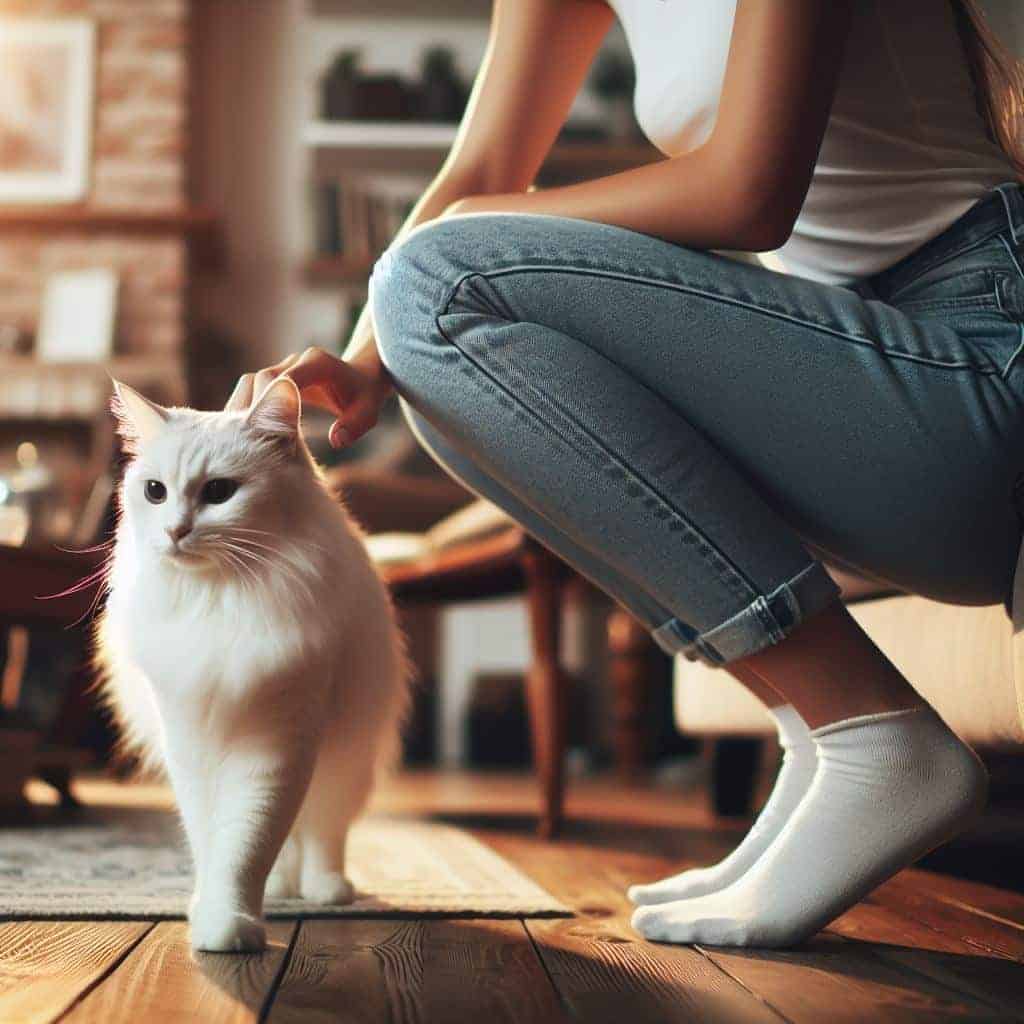
Have you ever wondered why your cat seems to reserve its meows exclusively for you? As a cat owner, I’ve often found myself intrigued by this curious behavior.
While we know that cats communicate in various ways—through body language, purring, and even their unique chirps—there’s something particularly fascinating about the way they use meowing.
It’s as if they’ve developed a special language just for us humans! In this blog post, I’ll explore the reasons behind this phenomenon, shedding light on the bond we share with our feline friends and what their meows really mean. 😺
Communication with Humans
Cats have developed a unique way of communicating specifically with humans, which is quite different from their interactions with other cats. This communication primarily involves vocalizations, body language, and behavioral cues that help them express their needs and emotions. Understanding these forms of communication can enhance the bond between cats and their human companions.
7 Ways How Cats Communicate with Humans
Attention Seeking
-
- Cats often meow to get attention from their owners. For example, if a cat sees you sitting on the couch engrossed in a book or watching TV, it might approach you and start meowing loudly to draw your focus away from what you’re doing.
- Practical Example: If your cat jumps onto your lap while purring and starts meowing when you’re busy working on the computer, it’s likely seeking interaction or playtime.
Expressing Hunger
-
- One common reason for a cat’s persistent meowing is hunger. They may develop specific vocalizations that signal they are ready for feeding.
- Practical Example: A cat might start meowing around its feeding time or even follow you into the kitchen as a way to remind you it’s time for dinner.
Seeking Comfort
-
- Cats may use vocalizations to seek comfort or reassurance from their human companions during stressful times such as thunderstorms or fireworks.
- Practical Example: If there’s a loud noise outside, your cat might come close to you and begin to softly meow while rubbing against your leg, indicating it wants solace.
Indicating Discomfort or Pain
-
- When cats are unwell or in pain, they may also use vocalization as an alert system for humans who can offer help.
- Practical Example: A normally quiet cat suddenly begins to cry out frequently; this could indicate discomfort due to illness or injury that requires veterinary attention.
Greeting Behavior
-
- Meowing can serve as a greeting when humans return home after being away for some time.
- Practical Example: You walk through the door after work only to be met by enthusiastic meows from your feline friend—this behavior shows excitement at seeing you again!
Expressing Loneliness
-
- Cats left alone for extended periods may vocalize more than usual upon their owner’s return as an expression of loneliness during separation.
- Practical Example: After leaving your cat alone all day while at work, it greets you at the door with loud cries—indicating its desire for companionship after feeling isolated.
Signaling Territory or Ownership
-
- Vocalizations can also communicate territory claims; cats will sometimes assert themselves vocally when they feel another animal (or even another person) is encroaching on what they consider theirs.
- Practical Example: If two pets are living together and one starts making loud noises whenever another approaches certain areas (like food bowls), it’s signaling ownership over those spaces.
Understanding how cats communicate allows us not only to respond appropriately but also deepens our relationship with them by recognizing their various needs through sound!
Once we start paying close attention to these behaviors alongside context clues like body language (e.g., tail position), we become better-equipped caretakers who can cater effectively to our feline friends’ emotional states and requirements. 🙌🏼
Evolutionary Adaptation
Evolutionary adaptation refers to the changes that occur in a species over time, enabling them to better survive and thrive in their environment.
In the context of domestic cats, these adaptations have significantly influenced how they communicate with humans, particularly through meowing. Understanding this concept involves looking at several factors that contribute to how communication has evolved between cats and humans.
3 Key Aspects of Evolutionary Adaptation
Domestication Process
The domestication of cats began around 9,000 years ago when humans transitioned from nomadic lifestyles to agricultural societies.
As humans started storing surplus grain, rodents became attracted to these food sources, leading wildcats to follow suit for easy hunting opportunities.
Over time, those wildcats that were less fearful of humans thrived due to the availability of food and shelter. This led to a mutually beneficial relationship where cats helped control pests while receiving care from humans.
Mimicking Human Infant Sounds
One fascinating aspect of cat communication is their ability to mimic sounds associated with human infants. When kittens meow, they produce high-pitched sounds similar to a baby’s cry.
This instinctive behavior may trigger nurturing responses in humans.
For example, when a cat meows like a baby crying for attention or comfort, it can elicit an emotional reaction from its owner who may feel compelled to respond positively—this reinforces the behavior over generations.
Enhanced Vocalization for Human Interaction
Unlike feral cats that primarily use body language and other vocalizations (like hissing or growling) among themselves, domestic cats have developed more complex vocalizations specifically aimed at interacting with people.
These enhanced vocal skills include varying pitch and tone based on different contexts; for instance:
-
-
- A short “meow” might indicate a greeting or acknowledgment.
- A series of urgent “meows” could signal hunger or distress.
-
This adaptability highlights how domestic cats have evolved their communication style specifically tailored for human interaction rather than just feline-to-feline exchanges.
Real-Life Scenarios
- Feeding Time: Many cat owners (myself included) notice that their pets develop distinct meows when it’s close to feeding time. Over repeated experiences where loud meowing results in being fed promptly by their owners, the cat learns this behavior is effective—demonstrating evolutionary adaptation through learned behaviors linked directly with survival needs. Doofy meows out loud whenever it is feeding time. 😹
- Attention Seeking: Cats often utilize specific types of meows when seeking attention from their owners versus communicating with other animals (e.g., chirps or trills). An owner might observe that if they respond positively (petting or playing) after hearing certain types of meows consistently used during playtime requests versus meal times—the cat adapts its vocal strategies accordingly over time.
Evolutionary adaptation helps us understand why domestic cats only meow at humans rather than each other. Their ability to modify communication methods reflects both historical relationships formed during domestication and ongoing interactions shaped by human responses—a fascinating interplay between species!
Behavioral and Psychological Factors
Understanding why cats meow at humans involves exploring various behavioral and psychological factors.
These elements help explain the underlying motivations behind their vocalizations, shedding light on how these interactions develop over time.
Learned Behavior
Cats are incredibly observant creatures, and they learn from their environment. When a cat meows at a human and receives attention or a response—such as being fed or petted—it reinforces that behavior.
- Example: If you have a cat that meows when it wants to play, and every time you respond by engaging in playtime, your cat learns that meowing is an effective way to get what it wants.
Positive Reinforcement
Positive reinforcement plays a significant role in shaping a cat’s behavior. This concept refers to rewarding desired behaviors to increase the likelihood of those behaviors being repeated. Cats quickly understand which actions yield positive outcomes.
- Example: If your cat meows for food and you immediately provide it with treats or meals, this creates a strong association between the act of meowing and receiving food. Over time, your cat may become more vocal in anticipation of meals because it has learned that this behavior results in rewards.
Social Bonding with Humans
Cats are social animals despite their independent nature; they form bonds with humans similar to how they might bond with other cats or animals within their environment. Vocalizations like meowing can be seen as an attempt to communicate emotions such as affection, trust, or even anxiety about separation.
- Example: A domesticated cat may follow its owner around the house while softly meowing as if trying to engage them in interaction or express companionship. This vocalization serves not only as communication but also strengthens the emotional connection between the pet and its owner.
Behavioral and psychological factors significantly influence why cats choose to communicate through meowing specifically directed at humans rather than other forms of communication used among themselves or in wild settings. Once we understand these dynamics—learned behaviors — we gain better insight into our feline companions’ unique ways of expressing themselves.
Final Thoughts
Understanding why cats only meow at humans involves recognizing the unique relationship between them and us. Their vocalizations serve specific purposes related to communication, social interaction, adaptation, variety in expression, and individual traits. By paying attention to your cat’s sounds and responding appropriately, you can strengthen your bond while also gaining insight into its needs!

In her previous life, Lisa traveled extensively, both for work and leisure. After the pandemic struck, Lisa locked up her luggage and adopted a cat ever since.
Lisa is now an avid cat lover, she devotes most of her free time serving as butler to her adorable feline at home. When she is not with her cat, she can be seen using her phone sourcing for the latest cat supplies online.


